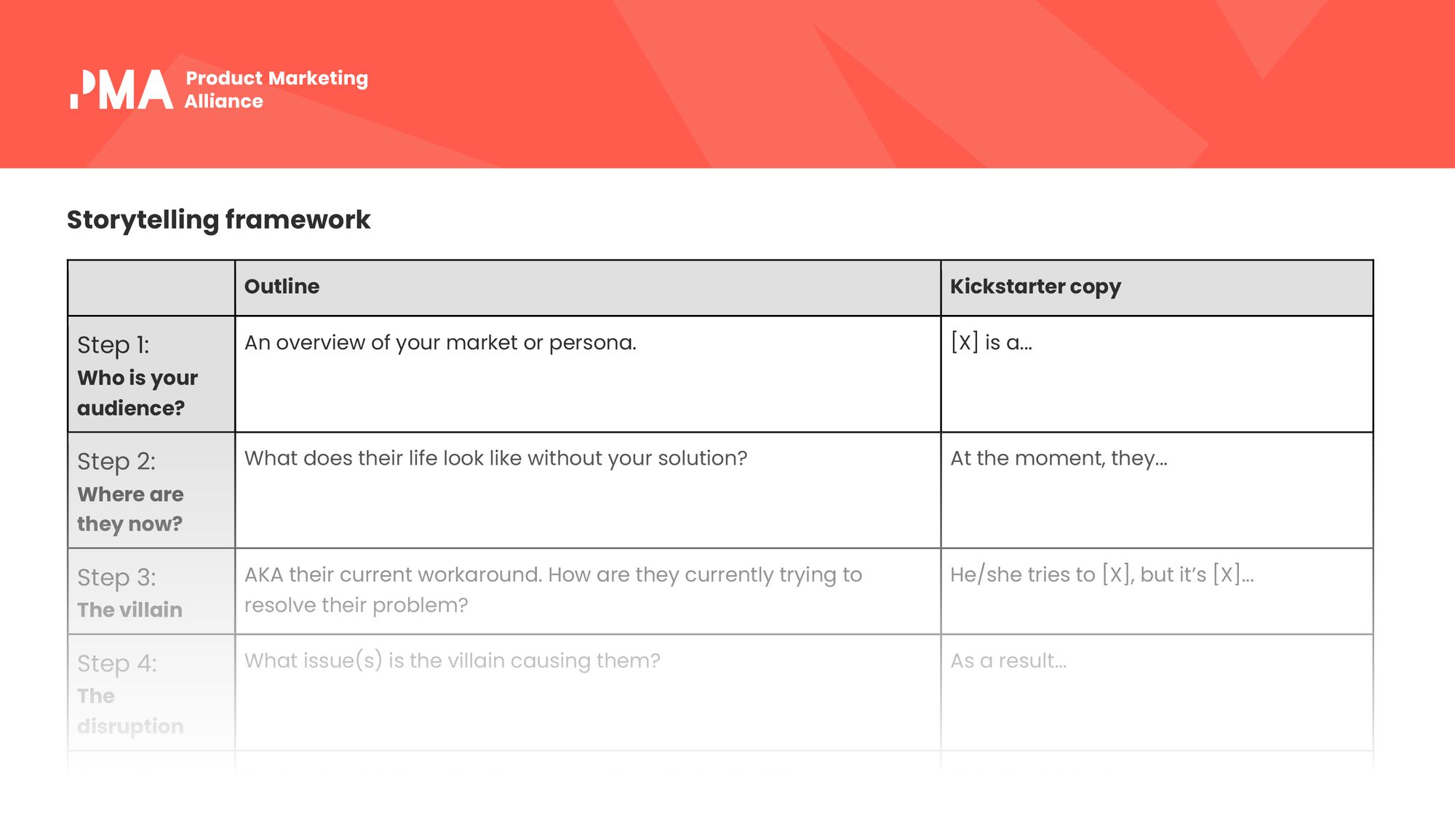What is storytelling?
Storytelling is a process used by product marketers to essentially communicate a message to their audience, via the combination of fact and narrative.

While many orgs use stories based on fact, others combine fiction and improvisation to drive home the key components of their brand's core message.
Why is storytelling important?
There isn’t a one-size-fits-all, definitive answer as to why companies put a storytelling process in place; it’s not a black and white scenario - there’s a whole shade of grey.
Companies tell stories to their audiences to:
- Sell a product,
- Entertain their audience,
- Educate the market about a new product or service,
- Highlight an achievement or landmark.
These vary from org-to-org, and no motive can be applied across the board; this will always change depending on contextual circumstances.
But why do companies decide to lean on storytelling as their go-to means of divulging information with their market?
They bring concepts to life and make complex messages easier to understand
Ever been hit with a cloud of confusion when someone’s trying their utmost to explain their idea to you?
Stories can slice through degrees of uncertainty and help people understand concepts.
Cast your mind back to when you couldn’t solve what seemed like an impossible algebra equation. After your tutor used real-life examples to make it more relatable, the penny dropped, and hey-presto, you were a math extraordinaire.
In this case, the tutor took a complex thought, put it in a language you’d understand, and simplified the process for you, allowing you to understand the theory.
Storytelling unites people
Storytelling formats can be applied on a global scale.
After all, we’ve all been privy to stories of heroes, underdogs, and heartbreak; these storytelling traits allow us to share common ties formed on emotions such as hope, anger, and happiness. Such tales bring people together and allow them to feel similar emotions, in turn, building a sense of community and familiarity.

The world is a divisive place, yet despite the daily obstacles faced as a result of conflict, storytelling is used as a tool whereby companies can bring people together and restore a sense of humanity, irrespective of where the audience is from, what language they speak, or their religious and/or political views.
Take TOMS, for example. The company has applied a relatively straight-forward storytelling method, simply sharing the stories of the people who they’re helping via the sales of their products. Not only does this bring their product and the message to life; since the formation of the company in 2006, TOMS has built a community of people contributing to the cause, with the community donating 100 million pairs of shoes to those in need.
The recipe for storytelling
It could be argued there’s no such thing as a ‘good’ or ‘bad’ story; after all, what’s one man’s trash, is another man’s treasure.

That said, we naturally aspire to create ‘good’ stories, and there are indispensable elements you cannot do without whilst putting together the pieces of your respective storytelling experience.
It’s considered good stories are:
- Entertaining: Enticing stories hook the audience and leaves them on-the-edge of their seat.
- Educational: If your story sparks curiosity, and teaches the audience something new, this is a sign you’re ticking the right boxes.
- Universal: As we said previously, storytelling is a universal language; those considered the best are relatable to readers all over the world and relate to a range of common emotions and experiences.
- Organized: There’s nothing worse than an elongated story, right? If a story is organized, this will keep users hooked, whilst delivering key takeaways.
- Memorable: The very best stories are like gum on a shoe: they stick. Whether your story’s inspiring, funny, or downright scandalous, you wanna burrow into the reader’s mind and set up camp.
How to tell your product’s story
Albanian soccer player Ledio Pano is renowned for his penalty-kick prowess, taking over 50 spot-kicks in his career, without missing.
Point being, his uncanny ability didn’t crop up from nowhere, it was the product of perseverance and practice. The storytelling process is no different - it’s an art, which follows a process.
So, why do you need to nail the process and make sure it’s 100% on-point?
For one, orgs and brands have a collection of messages they’ll be keen to communicate within their piece, and you need to be sure you have a coherent structure in place.
Unsure how to map your process? No worries - we’ve done it for you.
Familiarize yourself with your audience
Before you even begin to think about writing your story, you need to establish:
- Who wants to hear your story,
- Who’ll not only benefit from the story itself,
- Who'll provide a tangible response?
Researching your target audience is essential to establish who your buyer personas are for your respective product.
Whilst delving into the finer details, not only will you familiarize yourself with your audience, but it’ll also provide a platform for when you’re sculpting your story’s foundations.
Specify your key message
You may be writing a blog post or the modern-day equivalent of War and Peace. Either way, you must always have a core message in place.
While some pop together stories to sell a product, others are campaigning for change, you can define your message by simply summarizing your message in 6-10 words.
If it’s proving problematic, you need to go back to the drawing board and revisit your core message.
Establish the story you want to tell
Everyone wants to tell something different - if we were all telling the same story, it’d be plain boring.
And boring will never sit well with your target audience.
Not only do you need to consider the emotions you want your audience to experience when they read your story, but also the action you want them to take after they’ve finished reading, listening or watching what's been put in front of them.
Ultimately, motives will change depending on your brand's mission. Orgs commonly set objectives to:
- Provoke action,
- Tell the audience about yourself,
- Demonstrate value,
- Bring people together and create a sense of community,
- Provide an educational insight.
Identify your CTA
In many ways, a company’s objective and CTA (call-to-action) have some similarities. However, a CTA establishes the action you want the audience to take when they’ve finished reading your story.
You may want your audience to sign-up for a service, donate to a charity, buy a product, or enroll on a course.
For example, WWE may have a CTA along the lines of ‘Donate Now’, while sports fans may be sent an email with the CTA ‘renew your season ticket today.’
Select an appropriate medium
Once upon a time, stories commonly took shape in the form of a written story, but now, they’re available in a variety of formats, to suit the needs of different audiences.
Add to that, the story medium will also depend on the type of story you’re telling, while additional factors such as budget and time are also taken into consideration.
There are a variety of mediums that can be used, including:
- Written: These commonly take the form of blogs, articles, or books. Mainly comprising text and images, written stories are a popular choice, given their low-costs. After all, anyone can set up a Google Docs account and get started writing their very own masterpiece, free of charge.
- Spoken: These types of stories are told in-person, with presentations, pitches, or panels examples of spoken formats. As these take place there and then, speakers need to fine-tune their delivery and there’s a chance errors may occur, but with practice, these can be an effective means of communicating directly with an audience and provoking emotional responses.
- Audio: These types of stories are similar to spoken formats, but they do differ slightly, as they’re pre-recorded. With many people listening to podcasts such as Product Marketing Life and Product Marketing Insider, audio stories have enjoyed a meteoric rise, to the point there’s been a demand for podcast clubs. With technology now much more affordable, more companies are enjoying its many benefits.
- Digital: These stories are told via a combination of media formats, including video, animation, interactivity, and games to encourage the audience to involve themselves in the narrative. In terms of generating an emotional response, this method is considered the most effective, and perhaps unsurprisingly, it carries a hefty price tag.
Time to write!
Ready to pop on your creative cap and start scribbling?
All of the building blocks are in place for you to craft a story your audience won’t want to end.

Need a framework to help you set the ball rolling? Owners of a PMA membership plan can get a storytelling framework, in addition to other frameworks and templates to alleviate their workload and raise the standards amongst their product marketing team.
Share the wealth
We’re sure you’ll be super-proud of your story, so why wouldn’t you want to show it off and promote it wherever possible?
Nonetheless, it’s not just a case of sharing it willy-nilly; there’s a method to the madness, and your platform will change, depending on what kind of story you’re telling.
For example, if you’ve opted for a business blog post, LinkedIn would be the perfect platform to do so. On the other hand, if you’ve opted for video content, the likes of Instagram, YouTube, or Vimeo will be more appropriate.
It’s also always recommended to host your content on your website. Include a hub section where visitors can find your podcasts, blogs, and written materials.
How does storytelling affect our brain?
Our minds are all wired differently and storytelling affects the human brain in several ways. The human brain is arranged to sort the applicable medium into stories, meaning we decipher narratives and can listen to other peoples’ stories with not only cognitive understanding but also apply a degree of empathy via a range of brain activities.

Our brain can be split into three parts:
- Reptilian brain: Instinctual brain,
- Limbic system: The emotional brain (paleomammalian complex) (including amygdala and hippocampus),
- Neocortex: Rational brain (neomammalian complex).
Story sharing activates not only the rational brain but also the emotional brain. Therefore, it’s considered more powerful than processing data and facts.
The limbic system is responsible for handling emotions (in the amygdala) and the creating memories (hippocampus). Both structures work cohesively when we’re given positive or negative stimuli.
This phase operates in both ways. The amygdala is activated by an external stimulus, for example, the smell of hot dogs at a baseball game. If this stimulus has a lasting impression, it’ll be etched into your memory by the hippocampus. Therefore, if you smelt a similar smell in the future, this triggers a memory.
If a story stimulates multiple senses, this can evoke empathy amongst your audience, creating a long-lasting memory.
The storytelling process has the potential to be immensely powerful; it can make us laugh, cry, or instill fear, without the reader experiencing the moment itself. Even if a story is a figment of someone’s imagination, there have been many instances whereby the audience has become engrossed in the material.
When we feel a certain emotion, FMRI scans have indicated different parts of the brain light up; the same can be said for when we experience someone else feeling the same emotion. This can be attributed to mirror-neurons; it’s fascinating to see the activity of mirror neurons heightens when the brain recognizes a narrative behind an action.
For example, if you’re talking with your friend in a cafe and they pick up a bottle of soda with a clear intention to drink it, mirror neurons become more active than if you observed your friend lifting a soda bottle and they proceeded to simply lift it without any follow-up action.
As well as when we’re listening to stories, mirror neurons are also activated when we observe actions, either real or artificial, and also when we’re imagining action. These processes create a basis for compassion, which is the key element of empathy.
Up-to-date research surrounding FMRI has indicated multiple areas of the brain contribute to empathy, including:
- Anterior insula: The integration of different feelings, place of identity perception.
- Amygdala: This section of the brain is responsible for aggression and fears.
- Prefrontal cortex: This allows us to recognize scenarios when we see subverted social norms and situations. It’s responsible for highlighting and coping with emotional conflicts, as well as problem-solving and conflicts in morality. This part of the brain also allows us to recognize the different options we have available to us, and it’s also responsible for the ability to recognize different options, allowing us to cooperate with other people as well as the ability to compare our point of view with different perspectives.
- Cingulate cortex: The cingulate cortex connects cognitive and emotional processes, enabling emotional instability and episodes of non-controlling of emotions and it’s activated when we’re faced with pain and/or suffering. Additionally, it is responsible for the personal dilemma and moral conflicts.
- Temporal-parietal junction: This plays an essential part in helping us judge the intentions and views of other people.
The multiple narratives we come across throughout our life continually shapes our thinking; when we see new narratives, the elasticity of the mind alters our train of thought.
How to improve your Go-to-Market knowledge
Delivered by Yoni Solomon, Chief Marketing Officer at Uptime.com, Go-to-Market Certified includes everything you need to design, launch, and measure an impactful go-to-market strategy.
By the end of the course, you'll be able to confidently:
🚀 Grasp a proven product launch formula that’s equal parts comprehensive, repeatable, creative, and collaborative.
🧠 Gain the expertise and know-how to build and tailor an ideal product blueprint of your own.
🛠 Equip yourself with templates to facilitate a seamless GTM process.


